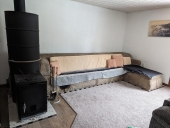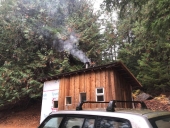Hi Yasmi;
Erica & Ernie built J-Tubes with a piped mass.
Batch boxes rarely utilize a piped mass but instead, more commonly use a stratification chamber (bell).
With a piped mass you want your J built to specifications, and you need a large smooth transition area where you enter the pipe system.
With a stratification chamber, things become easier.
There is still a CSA for bell size that should be followed although, using a bypass that can be exceeded.
Your core, be it a J-Tube or a batch box needs to be built to specifications, any little changes can affect rocket performance dramatically.
Once the super-heated air leaves the riser and enters the bell, it has no choice but to rise to the top. After arriving at the top it is instantly replaced by even hotter air. The cooler air sinks lower as the hotter air replaces it at the top. At the bottom of your bell is the outlet chimney. The still-hot air discovers this pipe and starts rising again(after all it's the hottest air in that pipe) this starts the draft going.
So, If building a J-Tube with a piped mass then all parameters must be strictly followed to get a successful build.
A J-Tube can be built using a stratification chamber rather than a piped mass.
Here is my shop stove as an 8" J-Tube into a brick bell.
https://permies.com/t/94980/Brick-Bell-Shop-Heater
https://permies.com/t/99519/Baby-Dragon-Roars
This design worked great until I decided I wanted to build my first batch box.
And here is where I changed it to a batch box.
https://permies.com/t/138779/Breaking-News-Shop-Dragon-admitted
And here is the latest configuration of The Shop Dragon
https://permies.com/t/181421/Batch-box-rebuild
https://permies.com/t/190599/Finishing-touches-Shop-Dragon-rebuild










